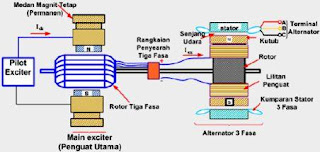Understanding the 3-Phase Synchronous Motor Operating Principle
Have you ever wondered how some of the most powerful and precise machines in industries operate? From power plants to robotics, 3-phase synchronous motors play a crucial role. These motors offer a unique blend of power, precision, and efficiency, making them ideal for a wide range of applications. Understanding their operating principle unlocks the secret to their remarkable performance.
The operational mechanism of a 3-phase synchronous motor revolves around the interaction of rotating magnetic fields. A 3-phase AC supply powers the stator windings, generating a rotating magnetic field. Simultaneously, the rotor, which contains a DC-excited field winding, produces its own magnetic field. The rotor then "locks" onto this rotating stator field and rotates at the synchronous speed, which is directly proportional to the supply frequency. This synchronization is the defining characteristic of synchronous motors.
Historically, the development of synchronous motors followed advancements in AC power systems. Early experiments with rotating magnetic fields paved the way for the invention of these motors. The need for constant-speed, high-power machines drove further innovations, leading to the sophisticated 3-phase synchronous motors we see today. Their significance stems from their ability to maintain a precise speed regardless of load variations within their operational limits, making them essential for applications requiring accurate timing and control.
The fundamental operating principle of a three-phase synchronous motor lies in the synchronization of the rotor's magnetic field with the rotating magnetic field produced by the stator. This synchronization is crucial for the motor's functionality. A key aspect of understanding these motors is grasping the relationship between the supply frequency, the number of poles in the motor, and the resulting synchronous speed. This relationship determines the motor's rotational speed and its suitability for specific tasks.
A common issue related to the function of 3-phase synchronous motors involves maintaining synchronization under varying load conditions. Sudden load changes can cause the rotor to lose its lock with the rotating stator field, resulting in instability and potential shutdown. Understanding the dynamics of the motor's response to load changes is vital for ensuring reliable operation and preventing synchronization issues.
One of the main advantages of synchronous motors is their ability to maintain a constant speed, independent of the load, as long as it's within the motor's capacity. This makes them ideal for applications requiring precise timing and control, like pumps, compressors, and industrial robots.
Another benefit is their high efficiency, particularly at higher power ratings. The synchronous operation minimizes losses due to slip, resulting in improved energy efficiency compared to induction motors. This efficiency translates to lower operating costs and reduced energy consumption.
Furthermore, 3-phase synchronous motors can be operated at leading power factor. By adjusting the excitation current to the rotor, the motor can generate reactive power, which can compensate for the lagging power factor typically caused by inductive loads in industrial settings. This capability improves the overall power factor of the system, reducing power losses and improving system stability.
Advantages and Disadvantages of 3-Phase Synchronous Motors
| Advantages | Disadvantages |
|---|---|
| Constant speed operation | Complex starting mechanism |
| High efficiency | Requires a separate DC excitation system |
| Power factor correction capability | Sensitive to voltage and frequency fluctuations |
Five best practices for implementing 3-phase synchronous motors include proper sizing for the intended application, ensuring a stable and reliable power supply, implementing appropriate starting mechanisms, regular maintenance including lubrication and inspection, and protecting the motor from overload and fault conditions through appropriate protective devices.
Some real-world examples of 3-phase synchronous motor applications include large industrial pumps, compressors in chemical plants, rolling mills in steel production, precise positioning systems in robotics, and generators in hydropower plants.
One common challenge is the complexity of starting a synchronous motor. Solutions involve using starting methods like pony motors, damper windings, or variable frequency drives. Another challenge is maintaining stable synchronization under varying load conditions. This can be addressed by employing advanced control systems that monitor and adjust the motor's excitation current to maintain stability.
Frequently asked questions include inquiries about the difference between synchronous and induction motors, methods for starting a synchronous motor, the importance of synchronization, the role of the excitation system, the benefits of power factor correction, the impact of load variations on performance, and troubleshooting common issues.
Tips and tricks for operating 3-phase synchronous motors involve regular monitoring of operating parameters like voltage, current, and temperature, ensuring proper lubrication and cooling, and conducting periodic inspections to detect and address potential issues before they escalate.
In conclusion, understanding the operating principle of 3-phase synchronous motors is essential for harnessing their full potential. These motors offer significant advantages, including constant speed operation, high efficiency, and power factor correction capabilities. By addressing the challenges associated with their operation and implementing best practices, industries can leverage the power and precision of these motors to enhance productivity, improve efficiency, and achieve optimal performance. The ongoing development of advanced control systems and monitoring techniques further strengthens their role in shaping the future of industrial automation and power generation. Explore the resources available, learn from the experiences of others, and unlock the full potential of these remarkable machines.
Unlocking perfect hues your guide to pc color matching tools
Aesthetic cute wallpaper phone tiny bubbles of joy in a sea of app icons
Decoding matt stetars financial success













